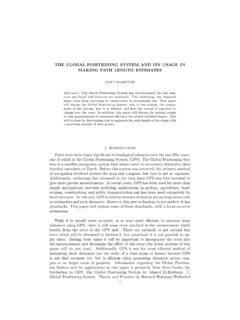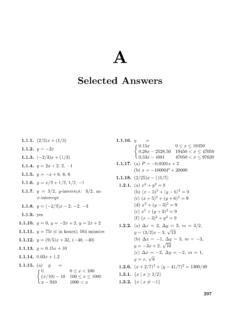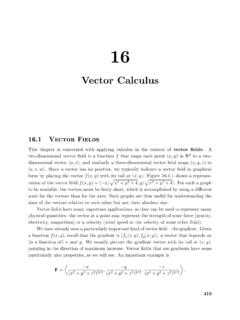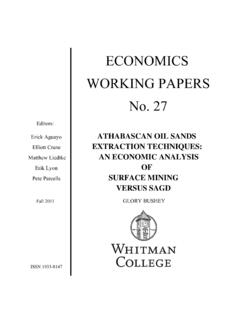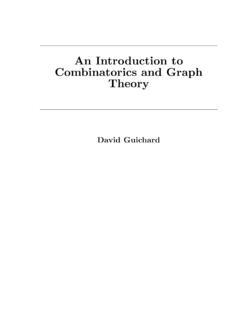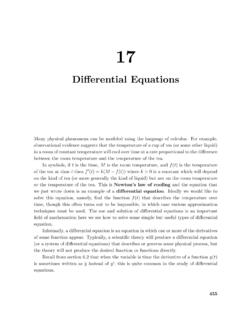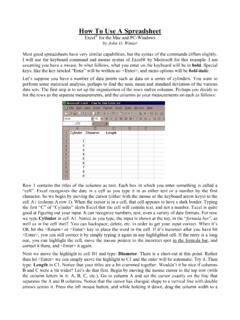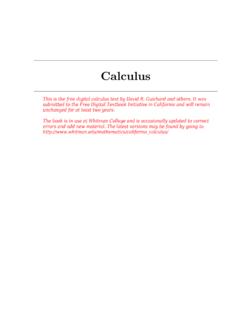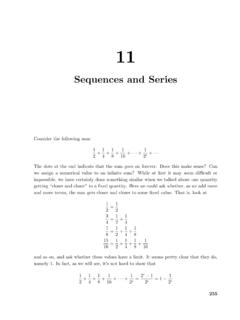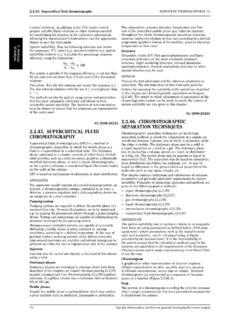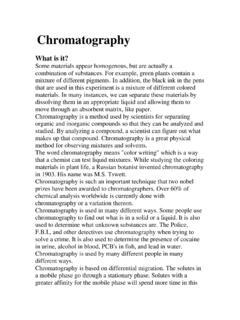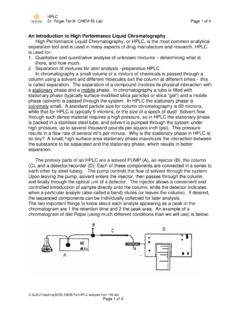Transcription of CHAPTER 1 Introduction, Chromatography Theory, and ...
1 1 CHAPTER 1 Introduction, Chromatography Theory, and Instrument Calibration Introduction Analytical chemists have few tools as powerful as Chromatography to measure distinct analytes in complex samples. The power of Chromatography comes from its ability to separate a mixture of compounds, or analytes , and determine their respective identity (chemical structure) and concentration. Chromatography can be divided into three basic types that include gas, liquid , and supercritical fluid Chromatography . liquid Chromatography can further be divided into ion exchange, separations based on size, and even extended to gel-based electrophoretic techniques. This book will provide a basic introduction to different types of liquid and gas Chromatography . The relationship between each type of Chromatography is illustrated in Figure Figure Categories of Chromatography and Their Relationship to Each Other.
2 2 In general, each type of Chromatography is comprised of two distinct steps: Chromatography (or separation of individual compounds in distinct elution bands) and identification (detection of each elution band). Gas Chromatography is the process of taking a sample and injecting it into the instrument, turning the solvent and analytes into gaseous form, and separating the mixture of compounds into individual peaks (and preferably individual compounds). liquid Chromatography completes the same process except the separations occur in a liquid phase. Individual band or peaks exit the column and identification occurs by a relatively universal detector. One particularly common detector for both gas and liquid Chromatography is mass spectrometry (MS) which transforms each analyte from a chemically neutral species into a positive cation, usually breaking various bonds in the process.
3 Detecting the mass of the individual pieces (referred to as fragments) allows for conclusive identification of the chemical structure of the analyte. Principles of gas Chromatography (GC) will be covered in CHAPTER 2, liquid Chromatography (LC) in CHAPTER 3, capillary electrophoresis (CE) in CHAPTER 4 and mass spectrometry (MS) in CHAPTER 5. In mass spectrometry, the combination of compound separation and ion fragment identification (the subject of CHAPTER 6) yields an extremely powerful analysis that is said to be confirmatory. Confirmatory analysis means the analyst is absolutely sure of the identity of the analyte. In contrast, many other individual techniques and detectors are only suggestive, meaning the analyst thinks they know the identity of an analyte. This is especially true with most universal GC and LC detectors since these detectors respond similarly to many compounds.
4 The only identifying factor in these chromatographic systems is their elution time from the column. In order to obtain confirmatory analysis the sample would need to analyzed by at least two or more techniques (for example, different separation columns) that yield the same results. Mass spectrometry and nuclear magnetic resonance (NMR) are two confirmatory techniques in chemistry. At this point, it is important to understand the different applications GC-MS and LC-MS offer for two different types of chemists, analytical and synthetic organic chemists. Organic chemists attempt to create a desired chemical structure by transforming functional groups and intentionally breaking or creating bonds; in their resulting identification procedures they already have a relatively good idea of the chemical structure.
5 To characterize the resulting product the chemist will use Infrared Spectroscopy (IR) to observe functional groups, Mass Spectrometry (MS) to obtain the compound s molecular weight, and Nuclear Magnetic Resonance (NMR) spectroscopy to determine the molecular structure. Information from all three techniques is used to conclusively identify the synthesized product. Analytical chemists are forced to approach identification in a different way, because they have no a priori knowledge of the chemical structure and because the analyte is usually present at low concentrations where IR and NMR are inaccurate. Often, analysis is performed to look for a desired compound by 3 comparing the sample analysis to that of a known (reference) compound. The reference is used to identify the unknown compound by matching retention time (in Chromatography ) and ion fragmentation pattern (in mass spectrometry).
6 With today s computer mass spectral libraries that contain ion fractionation patterns for numerous chemicals, the analyst has the option of not using a reference standard. This is especially valuable if a reference compound is not available or is expensive. In some cases, especially with low analyte concentration, this approach may only result in a tentative identification. This book will focus on GC-MS and LC-MS applications from an analytical chemistry perspective even though many synthetic chemists will also find much of this information useful for their applications. chromatographic Theory All chromatographic systems have a mobile phase that transports the analytes through the column and a stationary phase coated onto the column or on the resin beads in the column. The stationary phase loosely interacts with each analyte based on its chemical structure, resulting in the separation of each analyte as a function of time spent in the separation column.
7 The less analytes interact with the stationary phase, the faster they are transported through the system. The reverse is true for less mobile analytes that have stronger interactions. Thus, the many analytes in a sample are identified by retention time in the system for a given set of conditions. In GC, these conditions include the gas (mobile phase) pressure, flow rate, linear velocity, and temperature of the separation column. In HPLC, the mobile phase ( liquid ) pressure, flow rate, linear velocity, and the polarity of the mobile phase all affect a compounds retention time. An illustration of retention time is shown in Figure The equation at the top of the figure will be discussed later during our mathematic development of Chromatography theory. Figure Identification of Analytes by Retention Time.
8 4 In the above figure, the minimum time that a non-retained chemical species will remain in the system is tM. All compounds will reside in the injector, column, and detector for at least this long. Any affinity for the stationary phase results in the compound being retained in the column causing it to elute from the column at a time greater than tM. This is represented by the two larger peaks that appear to the right in Figure , with retention times tRA and tRB. Compound B has more affinity for the stationary phase than compound A because it exited the column last. A net retention (tR A and tR B) time can be calculated by subtracting the retention time of the mobile phase(tM) from the peaks retention time (tRA and tRB). Figure also illustrates how peak shape is related to retention time.
9 The widening of peak B is caused by longitudinal diffusion (diffusion of the analyte as the peak moves down the length of the column). This relationship is usually the reason why integration by area, and not height, is utilized. However, compounds eluting at similar retention times will have near identical peak shapes and widths. A summary of these concepts and data handling techniques is shown in Animation Animation Baseline Resolution. Go to in the download folder to view and play. 5 chromatographic columns adhere by the old adage like dissolves like to achieve the separation of a complex mixture of chemicals. Columns are coated with a variety of stationary phases or chemical coatings on the column wall in capillary columns or on the inert column packing in packed columns.
10 When selecting a column s stationary phase, it is important to select a phase possessing similar intermolecular bonding forces to those characteristic of the analyte. For example, for the separation of a series of alcohols, the stationary should be able to undergo hydrogen bonding with the alcohols. When attempting to separate a mixture of non-polar chemicals such as aliphatic or aromatic hydrocarbons, the column phase should be non-polar (interacting with the analyte via van der Waals forces). Selection of a similar phase with similar intermolecular forces will allow more interaction between the separation column and structurally similar analytes and increase their retention time in the column. This results in a better separation of structurally similar analytes. Specific stationary phases for GC and HPLC will be discussed later in CHAPTER 2 and 3, respectively.
